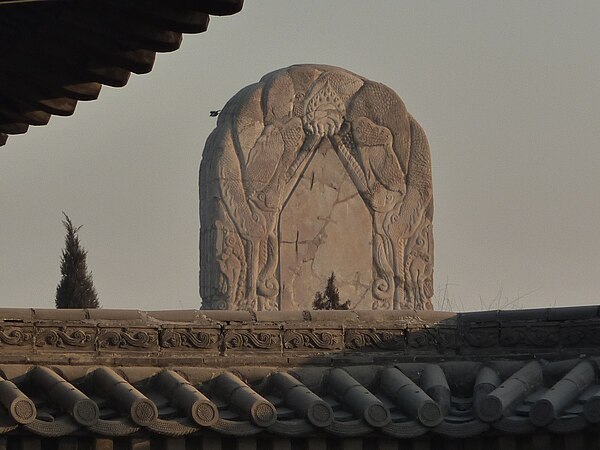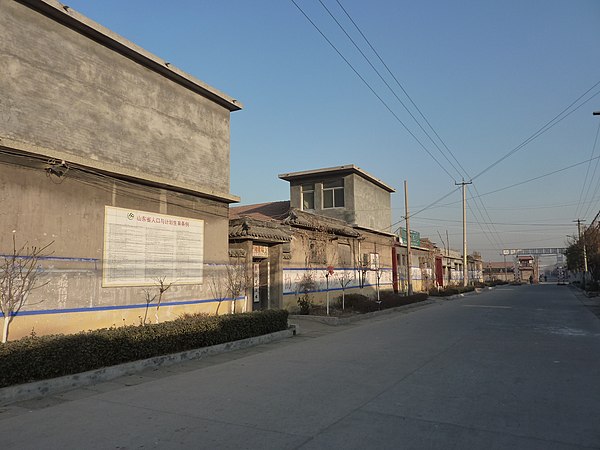 This January, I spent a few days in Qufu, Shandong. The city is mostly known as the hometown of Confucius, and the guidebooks, accordingly, spend plenty of space discussing the ''San Kong'' (Three Confucian [Sites]): the Confucius Temple, the Confucius Mansion, and the Confucius Cemetery. Qufu, however, is not only Confucius' hometown: the guidebook also had a few lines about something called Shou Qiu (寿丘, "Longevity Hill"), said to the birthplace of the Yellow Emperor, the legendary founder of the Chinese nation, and the adjacent tomb of his son Shaohao (少昊陵, Shaohao Ling). Not a lot of details though. I had a spare morning, so I decided to go an see what it's all about. The place is in Jiuxian village, on the east side of Qufu - about 4 km from the historical center (the old walled city, where the Confucius Temple and Mansion are). So if that's where you're staying, you can take a city bus (I think no. 2) to get to Jiuxian. That January morning I was walking though, as I wanted to see a bit more of the city outside of the center. Following the highway sign, I came to where Shaohao Tomb and Shou Qiu were supposed to be... but all you could see from the outside were a brick wall and a closed gate with a "beware of the dog" sign. But no, that wasn't all: you could also see the tops of two giant dragon-crowned steles rising high above the wall:
This January, I spent a few days in Qufu, Shandong. The city is mostly known as the hometown of Confucius, and the guidebooks, accordingly, spend plenty of space discussing the ''San Kong'' (Three Confucian [Sites]): the Confucius Temple, the Confucius Mansion, and the Confucius Cemetery. Qufu, however, is not only Confucius' hometown: the guidebook also had a few lines about something called Shou Qiu (寿丘, "Longevity Hill"), said to the birthplace of the Yellow Emperor, the legendary founder of the Chinese nation, and the adjacent tomb of his son Shaohao (少昊陵, Shaohao Ling). Not a lot of details though. I had a spare morning, so I decided to go an see what it's all about. The place is in Jiuxian village, on the east side of Qufu - about 4 km from the historical center (the old walled city, where the Confucius Temple and Mansion are). So if that's where you're staying, you can take a city bus (I think no. 2) to get to Jiuxian. That January morning I was walking though, as I wanted to see a bit more of the city outside of the center. Following the highway sign, I came to where Shaohao Tomb and Shou Qiu were supposed to be... but all you could see from the outside were a brick wall and a closed gate with a "beware of the dog" sign. But no, that wasn't all: you could also see the tops of two giant dragon-crowned steles rising high above the wall:  That certainly was intriguing enough, so I went on a walk around Jiuxian, looking for something that was open. Nothing much was, though, at this early hour - they did not even seem to have a noodle shop or a mantou stall. A house in the main street was decorated with the text of some provincial regulations dealing with family planning - and I don't mean it was just a slogan or a summary painted on the wall (as I'd see all over the place in rural China): it was actually done in tilework, with an eye toward permanence:
That certainly was intriguing enough, so I went on a walk around Jiuxian, looking for something that was open. Nothing much was, though, at this early hour - they did not even seem to have a noodle shop or a mantou stall. A house in the main street was decorated with the text of some provincial regulations dealing with family planning - and I don't mean it was just a slogan or a summary painted on the wall (as I'd see all over the place in rural China): it was actually done in tilework, with an eye toward permanence:  (Here's a close-up). Walking out of the village to the fields north of it, and then coming back toward where the giant steles had been seen, I saw the gates of another compound, now indeed labeled "Shaohao Tomb" (少昊陵, Shaohao Ling). Sure enough, there was a ticket booth, and the entry fee was a rather outrageous Y50 (about US$8 - more than a daily wage for an average blue-collar worker or a service sector worker in the area). I was the day's first visitor, and, considering the frosty weather, I would not be surprised if I turned out that day's only visitor. As the guidebook says, the Shaohao Tomb site indeed has a small pyramid (probably, just an earth structure faced with stones), and an earth tumulus next to it. I suppose the stone pyramid design is indeed unusual for China, but that's of course no Cheops Pyramid. This all of course was said to be a Song Dynasty site (ca. AD 1000-1100) - but, really, with a backhoe, a supply of stone blocks and a few hired hands I probably could build such a pyramid myself within a reasonable time frame.
(Here's a close-up). Walking out of the village to the fields north of it, and then coming back toward where the giant steles had been seen, I saw the gates of another compound, now indeed labeled "Shaohao Tomb" (少昊陵, Shaohao Ling). Sure enough, there was a ticket booth, and the entry fee was a rather outrageous Y50 (about US$8 - more than a daily wage for an average blue-collar worker or a service sector worker in the area). I was the day's first visitor, and, considering the frosty weather, I would not be surprised if I turned out that day's only visitor. As the guidebook says, the Shaohao Tomb site indeed has a small pyramid (probably, just an earth structure faced with stones), and an earth tumulus next to it. I suppose the stone pyramid design is indeed unusual for China, but that's of course no Cheops Pyramid. This all of course was said to be a Song Dynasty site (ca. AD 1000-1100) - but, really, with a backhoe, a supply of stone blocks and a few hired hands I probably could build such a pyramid myself within a reasonable time frame.  And yes, there was a cage with a guard dog in a corner:
And yes, there was a cage with a guard dog in a corner:  A tragic figure, early in his reign Huizong saw the rise of the Jurchen barbarians of the far north, and probably welcomed them as a force potentially useful against the other barbarians, the Kidan, whose Liao Empire had been the Song's rival for two centuries. Alas, having destroyed the Liao, Jurchen did not stop for too long before destroying the Song as well, and Huizong ended his days in captivity somewhere not too far from today's Harbin.
A tragic figure, early in his reign Huizong saw the rise of the Jurchen barbarians of the far north, and probably welcomed them as a force potentially useful against the other barbarians, the Kidan, whose Liao Empire had been the Song's rival for two centuries. Alas, having destroyed the Liao, Jurchen did not stop for too long before destroying the Song as well, and Huizong ended his days in captivity somewhere not too far from today's Harbin.  The book claims that Huizong had four steles (all on twenty-footer turtles? the book is silent about it) erected in front of the Jingling Palace, but, apparently, they did not keep standing for too long after the Jurchen conquest. (However, one of the steles does have text - two letters 庆寿, "Celebrate Longevity" - written over a century later, under the Yuan Dynasty. The other is still blank, is known as ''Wan Ren Chou Bei'' (万人愁碑, "The Sorrow of Ten Thousand People"), on account of its weight (over 300 tons) and the effort involved in its carving and transporting.
The book claims that Huizong had four steles (all on twenty-footer turtles? the book is silent about it) erected in front of the Jingling Palace, but, apparently, they did not keep standing for too long after the Jurchen conquest. (However, one of the steles does have text - two letters 庆寿, "Celebrate Longevity" - written over a century later, under the Yuan Dynasty. The other is still blank, is known as ''Wan Ren Chou Bei'' (万人愁碑, "The Sorrow of Ten Thousand People"), on account of its weight (over 300 tons) and the effort involved in its carving and transporting.  I have no idea what happened to the other two steles, but the two we see today were put together, from many pieces, and re-erected in 1991 and 1992. The tortoises, at least their faces, seem to be in remarkably good condition, so I wonder to which extent they are the actual restored Huizong turtles, and to which extent they are modern work; but in any effect, the entire ensemble is impressive, and is certainly worth visiting if you are in Qufu.
I have no idea what happened to the other two steles, but the two we see today were put together, from many pieces, and re-erected in 1991 and 1992. The tortoises, at least their faces, seem to be in remarkably good condition, so I wonder to which extent they are the actual restored Huizong turtles, and to which extent they are modern work; but in any effect, the entire ensemble is impressive, and is certainly worth visiting if you are in Qufu.P.S. Not that getting to Qufu was difficult before, but with the opening of the Beijing-Shanghai High-Speed Railway in July 2011, on which Qufu has a station, you can get there in style. Now the Yellow Emperor's pyramid and giant turtles are within 3 hours' train ride from any of Beijing, Nanjing, Shanghai, or Qingdao.
https://factsclubs.com/british-jokes-funny-jokes/">British Jokes
ReplyDeleteersilcons-yu Colleen Kennedy Here
ReplyDeletestanontugood
YinarOvie_ri Srinivas Blaschko Microsoft Visio Professional
ReplyDeleteOutByte PC Repair 1.7.112.7856
Express VPN
Topaz Video Enhance AI 2.6.4
ticksolsuce